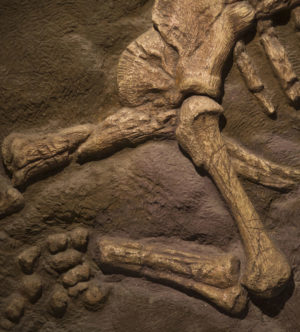 In the year 2000, archaeologists in Ethiopia uncovered the fossilized skeleton of a human ancestor classified as Australopithecus afarensis. The skeleton was of a roughly 3-year-old girl, and scientists believe she died about 3.3 million years ago. The team of archaeologist named her Selam, and what’s unique about her is that she is that most complete juvenile skeleton of an early-human ancestor ever discovered.
In the year 2000, archaeologists in Ethiopia uncovered the fossilized skeleton of a human ancestor classified as Australopithecus afarensis. The skeleton was of a roughly 3-year-old girl, and scientists believe she died about 3.3 million years ago. The team of archaeologist named her Selam, and what’s unique about her is that she is that most complete juvenile skeleton of an early-human ancestor ever discovered.
It took the team of researchers six years to safely unearth the skeleton from the ground, and it has taken another 12 years for another team to image and reveal the chunks of rock that contained her foot bones. All that methodical work has paid off, as we’ve been left with a complete picture of how Selam’s foot was structured. This allows us to learn more about our transition from walking on four limbs to the bipedal gait we use today.
The Foot of Our Ancestors
Selam’s foot structure was preserved such that researchers were able to gain valuable insights into how her feet functioned when she was alive. According to researchers, her big toe is larger and more flexible than a modern-day human child’s toe. Anthropologists have long argued that longer, more flexible toes were primarily used to assist in climbing trees, while shorter, stubbier toes were signs of bipedal walking. Essentially, as we become better walkers, we lose our some of our ability to climb faster.
Chimpanzees are modern humans’ closest living relatives, as we share a common relative 7 million years in the past. Both chimps and humans have the same 26 foot bones, although they are shaped differently, and that makes a world of difference in how we use our foot. Researchers say that Selam’s foot is somewhere between a chimpanzee’s foot and a human’s foot. Her big toe wasn’t quite as long as a chimps, but it had more grasping ability than a human’s big toe.
This finding suggests that Selam lived during a time when the transition from climbers to bipedal movement was taking place. They believe Selam was bipedal, as they also noted that she had a slight foot arch, but stated that she also climbed trees when necessary for protection or while looking for food.
It’s fascinating to see the evolution of the human foot and how much information can be gleaned from a single, well preserved fossil. Hopefully we can continue to learn more about our early ancestors and how they used their feet compared to how they function today.